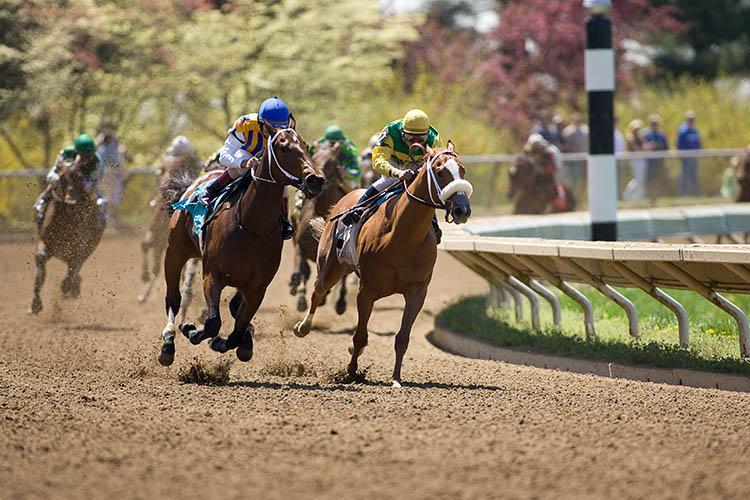UK Equine Research Showcase Recap: Researching mRNA Expression in Thoroughbreds with Catastrophic Racing Injuries
 Allen Page, DVM, PhD, scientist and veterinarian at the University of Kentucky Gluck Equine Research Center, spoke about a recently published paper from his laboratory on the expression of select mRNA transcripts in Thoroughbreds at the fourth and final session of the virtual 10th annual UK Equine Research Showcase, comparing horses that suffered catastrophic racing injuries to controls. The event was sponsored by BET, Kentucky Performance Products, McCauley’s, Merck, Rood & Riddle Equine Hospital and Tribute Equine Nutrition.
Allen Page, DVM, PhD, scientist and veterinarian at the University of Kentucky Gluck Equine Research Center, spoke about a recently published paper from his laboratory on the expression of select mRNA transcripts in Thoroughbreds at the fourth and final session of the virtual 10th annual UK Equine Research Showcase, comparing horses that suffered catastrophic racing injuries to controls. The event was sponsored by BET, Kentucky Performance Products, McCauley’s, Merck, Rood & Riddle Equine Hospital and Tribute Equine Nutrition.
“In our lab, a lot of the work that we do relies on inflammatory gene expression analysis. What that means is that we are measuring differences in whole-blood messenger RNA (mRNA) markers,” Page said.
Page shared a couple different reasons his lab has opted to focus on mRNA. First, horses are not often a priority target for a lot of companies that make laboratory reagents, so being able to look at a wide variety of proteins is difficult. Second, polymerase chain reaction (PCR) analysis of mRNA expression is highly sensitive and specific to the targets they are interested in. Lastly, changes in inflammatory mRNA markers take hours to be detectable. This means, for many transcript targets, that samples taken immediately post-injury likely reflect the pre-race status of the horse.
As a primer, Page described exercise-induced inflammation and how it occurs.
“Exercise-induced inflammation is a result of exercise-induced tissue damage. That can be mechanical damage to bone and soft tissue but can also be due to lactic acid and free radical accumulation. Regardless of how it happens, it ultimately results in the release of different damage-associated molecular patterns (DAMPs). DAMPs will work via a variety of different pathways, but all ultimately end up causing a release of pro-inflammatory cytokines,” Page said.
Exercise-induced inflammation is normal, he said, and is associated with the response of tissues to high level physical activity. It is important and necessary for tissue healing and repair, although it is thought that exaggerated inflammatory responses might be associated with injuries.
According to Page, there has been a lot of work done by others that show most catastrophic injuries occur either in limbs with pre-existing pathology/damage or in the opposite limb.
“Ours and others’ research have theorized that this damage may stimulate the production of specific biomarkers or proteins, or in our case, a non-specific inflammatory response that can be quantified and monitored,” Page said.
Describing his project, Page said the study’s hypothesis is that Thoroughbred racehorses that experience catastrophic (fatal) injuries while racing will have evidence of increased inflammation when compared to non-injured control horses.
“The goal of this project was to enroll 150 catastrophically injured horses and then enroll 300 post-race control horses that are matched to the injured horses. Those samples were collected post-race in the drug detection barn from horses that were in the same race as a catastrophically injured horse. We were also hoping to get around 700 pre-race controls that are sampled randomly to provide us with an idea of what the general racing population looks like,” Page said.
This study took place from September 2017 to May 2020 in four different state jurisdictions as well as at one individual racetrack. A total of 904 samples were collected, representing 107 horses with catastrophic injuries, 205 post-race control samples, 374 pre-race control samples and 218 samples excluded from the study for various reasons.
“We had a lot of exclusion criteria for this study, so horses that maybe had a catastrophic injury but were known to have clipped heels or fallen over another horse weren’t included because we weren’t sure that they necessarily would have been injured in that race. Likewise, we excluded a number of our control samples because they didn’t race again within a certain amount of time, and we were concerned that maybe they had an underlying issue that wasn’t known to us. They may have had an injury that could have biased our data,” Page said.
The first thing Page wanted to do before examining the injuries was to look into the effects from racing on inflammation. Previous work on horses showed that inflammatory mRNA changes take hours to manifest in response to exercise. That work has almost been exclusively done in horses either in short-distance race training or through work on treadmills, and not post-racing.
Page’s team used paired pre-race and post-race samples from the same horses to evaluate the effect of racing on 21 different mRNA markers. In the end, they had to eliminate 12 markers from analysis due to race-related effects. Out of the nine that were remaining, three markers showed promise in identifying horses at risk of catastrophic injury.
The three individual markers of interest were Insulin-like Growth Factor 1 (IGF-1), Matrix Metalloproteinase-2 (MMP2) and IL-1 Receptor Antagonist (IL1RN). Ultimately these three markers may provide economical, effective and non-invasive means of detecting horses at risk for catastrophic injuries.
Sabrina Jacobs, a senior majoring in equine science and management and minoring in wildlife biology and management, is a communications and student relations intern with UK Ag Equine Programs.
